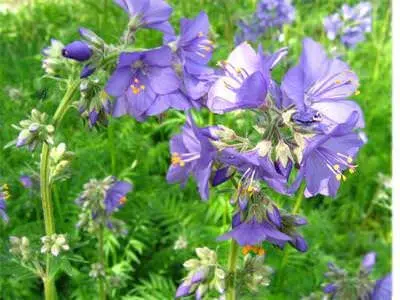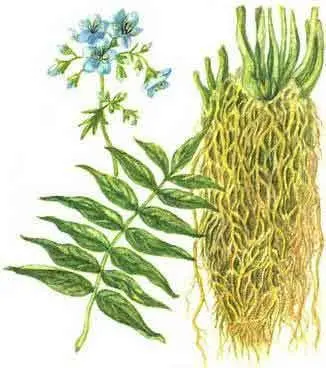Contents
Useful properties, cultivation and recipes for the use of cyanosis
Botanical characteristics of cyanosis

Blue cyanosis is a low perennial plant with an unbranched rhizome. The cyanosis stem is erect, simple and hollow. On indistinctly ribbed stems are alternate leaves, glabrous, consisting of 7–13 leaflets. The leaves are shifted towards each other, sharp, the shape is ovate-lanceolate. Blue flowers are not only blue, as the name of the plant may seem: there are white, purple, purple and blue. They are collected in inflorescences-panicles. The fruit of the cyanosis is a box consisting of three nests. Inside the box there are many narrow-winged, dark brown small seeds.
The cyanosis blooms in early summer, its flowering lasts only one month. The fruits of the plant ripen from late summer to early autumn. It grows in forests and forest-steppe zones throughout Russia, Siberia and Western Europe. The cyanosis usually grows in small groups, but it happens that it can be seen solitary among the bushes and in the meadows and edges.
Cultivation of cyanosis blue
The blueberry is a moisture-loving plant that is calm to low temperatures. The plant tolerates drought heavily. For growing cyanosis, it is necessary to choose a low-lying area in which groundwater does not lie to a great depth. The cyanosis does not grow well on saline and strongly acidic soils.
Sinyukha is grown by seed. To grow a plant, you need to collect mature seeds. Seeds are fully ripe when the pods of the plant turn brown. Seeds are collected by shaking off the boxes with them, after which the seeds are dried and cleaned.
Sowing seeds can be done before winter or in the first days of spring. Sow the seeds in the usual way. If the seeds are sown before winter, then you need to choose a soil that does not swim, with flat areas. Before sowing, the soil must be leveled and compacted. If the seeds are sown in the spring, they must be stratified before sowing. To do this, the seeds are placed in wet sand for 3-4 days. As soon as the seeds germinate, they are sown in the ground, planting 1–2 cm into the soil.
For good and fast emergence of seedlings, the soil must be at a temperature of 20 °C above zero. If favorable conditions are created, then seedlings will appear on the 5th day. After the emergence of seedlings, it is necessary to weed the soil, regularly water and loosen. The cyanosis has one feature – self-thinning. This means that it does not need thinning when planting heavily. In early spring, fertilize the soil between the rows.
Useful properties of cyanosis

Blue cyanosis contains in its composition triterpene saponins, due to the action of which it is used as an excellent expectorant. A decoction of this plant helps with diseases of the respiratory organs. Cyanosis has a calming property, it lowers nervous excitability and lowers blood pressure. The plant normalizes metabolism and has a positive effect on blood clotting.
Saponins contained in the plant stop the development of atherosclerosis. Cyanosis also has a sedative property, which is used for violations of the central nervous system. Also, this plant normalizes cholesterol metabolism. Cyanosis helps reduce chest pain and stop inflammation in the body.
Application of cyanosis blue
Traditional medicine has long used cyanosis in the treatment of various diseases. For medicinal purposes, the herb and rhizome of the plant are used. Most often, cyanosis is used in the form of infusions and decoctions. The plant is recommended to be used as a medicine in the treatment of bronchitis, lung abscess, tuberculosis, coughs and colds.
In folk medicine, cyanosis received a new name – “blue valerian”, because it is used instead of valerian. It helps to cope with insomnia, cure fright, dysentery and neurasthenia.
Infusion of cyanosis with a cold. To prepare it, you need to take 6 grams of cyanosis roots and grind into powder. Next, pour the powder with a glass of water and leave for about 1 hour. Take the infusion three times a day, 1 tablespoon.
Decoction of bluish cough. Take 2 tablespoons of the roots of the plant and pour 200 ml of boiling water, put in a water bath for 15 minutes and remove from heat. Let the product stand for 1 hour. Then strain the broth and bring it to the original volume with boiling water. It is necessary to take such a medicine 1 tablespoon three times a day after meals.
Cyanosis tincture for epilepsy. We take 10 grams of cyanosis roots and grind them to a powder state. Pour the cyanosis powder with a glass of 70% alcohol and leave to infuse for 14 days. Do not forget to shake the composition after a couple of hours. We filter the finished tincture and take 15 drops three times a day.
Contraindications to the use of cyanosis blue
You can not take drugs from cyanosis on an empty stomach. Blueberry should only be consumed in the prescribed doses, and if taken in excess, it can lead to vomiting, diarrhea, and headaches.









